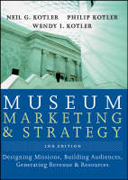
Museum marketing and strategy: designing missions, building audiences, generating revenue and resources
Kotler, Neil G.
This new edition of the bestselling guide on marketing for museums is thoroughly updated, addressing the growing impact of technology, shifts in museum branding and marketing strategy, and also adds international case studies. Written by Neil Kotler along with his brother Phillip, the father of modern marketing, this book reflects the changing museum world. The rapid growth in the number museums worldwide, coupled with greater receptivity on the part of museum managers and boards regarding marketing solutions has created an atmosphere in which museum managers are seeking ways to be more strategic and creative in order to reach their institution's goals. INDICE: Figures, Tables, and Exhibits. Model Museum Practices. Preface. Acknowledgments. The Authors. PART ONE: MUSEUMS AND MARKETING. 1. The Diverse World of Museums. Museum Experiences. What Is a Museum?. Origin and Evolution ofMuseums. Summary. 2. The Role of Museum Marketing. Exchange Transactions and Relationships. The Role of a Marketer. The Marketing Concept. Strategic Marketing. Marketing Core Concepts. Developing Marketing Plans. Characteristics of aConsumer-Centered Museum. The Impact of the Digital Revolution on Marketing. Summary. Model Museum Practice: Museum of Science, Boston. PART TWO: STRATEGICMARKETING. 3. Moving to Strategic Planning. Strategic Planning. Strategic Market Planning Process. The Environmental Scan. Undertaking a Marketing Audit. Summary. Model Museum Practice: National Gallery of Victoria. 4. Choosing a Mission and Core Strategy. A Museum Chooses Its Mission. Setting the Core Marketing Strategy. Product Portfolio Strategy. Organizational Structure and Culture.Human Resources. Summary. Model Museum Practice: The Strong National Museum of Play. 5. Applying Market Segmentation, Targeting, Positioning, and Branding.Approaches to Markets. Steps in Segmenting, Targeting, and Positioning. Basesfor Segmenting Markets. Targeting Specific Market Segments. Positioning the Museum and Its Offerings. Museum Branding and Brands. Summary. Model Museum Practice: Chicago History Museum. PART THREE: MUSEUM CHALLENGES AND OPPORTUNITIES. 6. Building Audiences. Attracting and Retaining an Audience. Attracting New Audiences. Information Gathering. Decision Evaluation. Decision Execution. Postpurchase Assessment and Action. Summary. Model Museum Practice: Fonthill Museum. 7. Attracting Financial Resources. The Impact of Economic Cycles on Museums. Museum Revenue Sources. Government Support. Earned Income. Attracting and Managing Donors. Fundraising Goals and Strategy. Investment Income. Improving Business Practices to Augment Income. Financing Opportunities. Summary. Model Museum Practice: The Freer and Sackler Galleries. PART FOUR: TACTICAL MARKETING. 8. Carrying Out Marketing Research. Museum Applications of Marketing Research. Major Types of Museum Research. Before Beginning the Research. Data Sourcesand Research Tools. Steps in the Marketing Survey Process. Marketing ResearchBudgeting. Resistance to Marketing Research. Summary. Model Museum Practice: The Newark Museum. 9. Developing Attractive Offerings. Collections and Exhibitions. Museum Programs. Museum Experiences. Museum Services. Purchasable Products. Summary. Model Museum Practice: 21st Century Museum of Contemporary Art, Kanazawa. 10. Distributing the Museums Offerings and Services. Distribution Channel Structure. Branch Museums. Traveling Exhibitions and Loans. Off-Site Programs. Museum Retail Channels. Museum Publications. Electronic Distribution. Consumer Convenience. Summary. Model Museum Practice: Great Britains Tate. 11. Managing Marketing Communications. The Communication Process. Advertising. Sales Promotion. Direct Marketing. Public Relations. Summary. Model Museum Practice: Museums and E-Communication. 12. Setting Pricing Strategies. Pricing Admission. Pricing Objects Loaned to Other Museums. Pricing Special Exhibitions and Events. Pricing Membership. Pricing Museum Shop Items. Pricing Facility Rental. Pricing Donor Support. Summary. 13. Managing Marketing Operations. Developing Marketing Budgets. Marketing Implementation. Power Relationships in Organizations. Marketing Information and Control Systems. Summary. CONCLUSION. 14. Securing the Future of Museums. Museums and Marketing. Achieving Expanded and Diverse Audiences. Expanding Capacity and Developing Exhibitions and Programs. Museum Partnerships. Encouraging Future Visitors and Experiences. Online Resources. References. Index.
- ISBN: 978-0-7879-9691-8
- Editorial: Jossey Bass
- Encuadernacion: Cartoné
- Páginas: 528
- Fecha Publicación: 01/08/2008
- Nº Volúmenes: 1
- Idioma: Inglés
